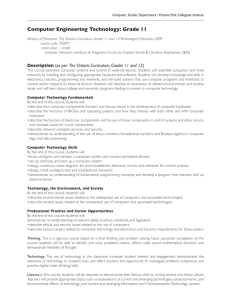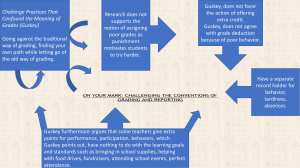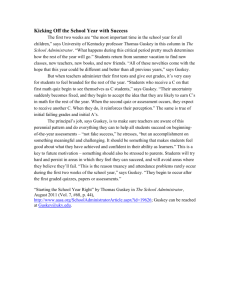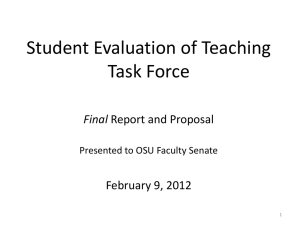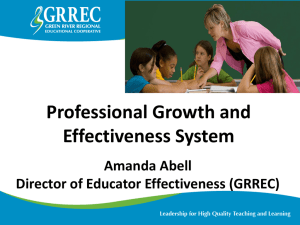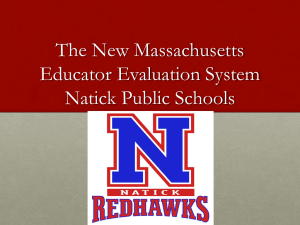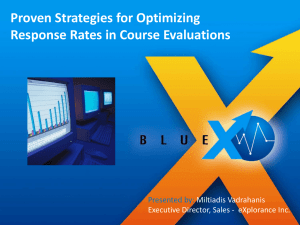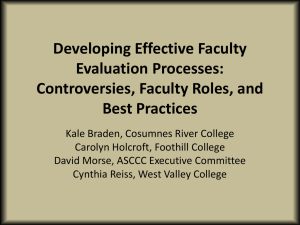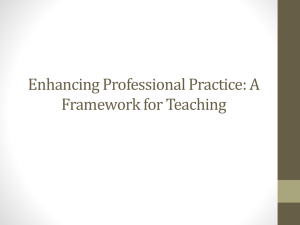Change
advertisement
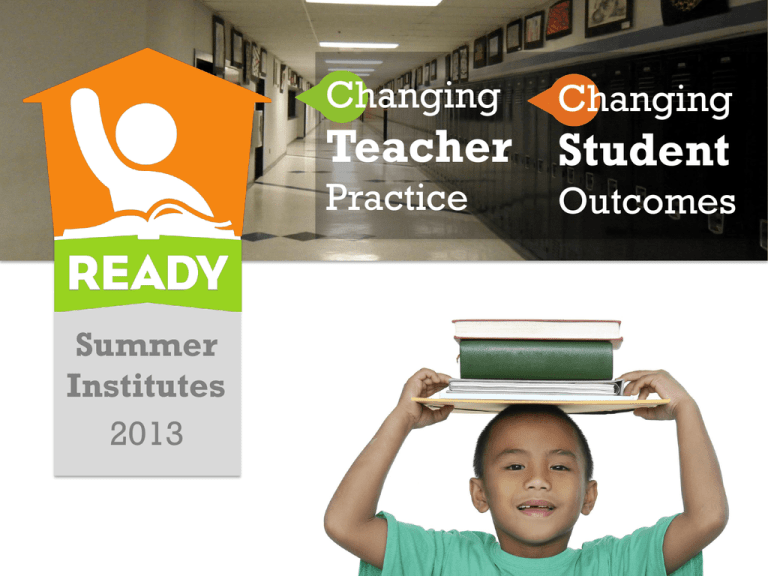
Changing Changing Teacher Student Practice Summer Institutes 2013 Outcomes How to use Professional Development to Ensure Improved Student Outcomes This presentation was adapted from Learning Forward, 2012 Our Outcomes • Define evaluation in relationship to professional learning; • Examine the process of teacher change and its impact on student learning; and • Acquire strategies, tools, and resources to assist in evaluating professional learning Building PD Capacity Toolkit (link) Our Essential Questions • How can evaluating professional learning leverage school, school system, and state improvement effort? • How will I align professional learning objectives to measurable short, medium and long-term results for educators and students? • How will I collaborate with others to construct a framework that outlines a detailed plan for evaluation? • How do I incorporate evaluation into my work and normative practice? “Norms” • Listen as an Ally • Value Differences http://ecx.images-amazon.com/images/I/51%2BU-UWbxmL._SY300_.jpg • Maintain Professionalism • Participate Actively The Standards for Professional Learning Professional learning that increases educator effectiveness and results for all students uses a variety of sources and types of student, educator, and system data to plan, assess, and evaluate professional learning. -Standards for Professional Learning, 2011 http://www.ncpublicschools.org/docs/effectivenessmodel/ncees/standards/prof-learn-quick-ref.pdf Link to Student Results 1. Standardsbased professional learning 2. Changes in educator knowledge, skills, and dispositions 4. Changes in student results 3. Changes in educator practice DuFour Questions • What do we want students to learn? • How will we know if they have learned it? • What will we do if they have? • What will we do if they haven’t? Apply this to Professional Learning: Full implementation vs. Full Participation Full Implementation - Evaluation A systematic, purposeful process of studying, reviewing, and analyzing data gathered from multiple sources in order to make informed decisions about a program. – Killion, 2008 The systematic investigation of merit and worth. – Thomas Guskey, 2000 Which best describes your experience? A B Externally driven and designed Internally driven and designed Summative evaluations only Planning, formative, and summative evaluation Event-based Program-based Looking for answers/solutions form others Discovering or creating solutions and alternatives with others Feared Embraced Filed/shelved Used Done as an afterthought Planned from the beginning Documentation Evaluation Process-focused Results-driven Presentation of results Reflective dialogue Shifting Perspectives From To Externally driven and designed Internally driven and designed Summative evaluations only Planning, formative, and summative evaluation Event-based Program-based Looking for answers/solutions form others Discovering or creating solutions and alternatives with others Feared Embraced Filed/shelved Used Done as an afterthought Planned from the beginning Documentation Evaluation Process-focused Results-driven Presentation of results Reflective dialogue Your Evaluation Process Write 4-5 sentences that describe the evaluation process/steps you currently use as a leader responsible for assisting others with evaluating professional learning. Tech Tool Idea: Penzu – online writing journal Group Think – Table talk, share out or Padlet 1. What aspect of evaluating professional learning do you find essential? 2. How do we know that the professional learning is making its way to the classroom? How and Why of Evaluation Good evaluations are the product of thoughtful planning, the ability to ask good questions, and a basic understanding about how to find valid answers. In many ways they are simply the refinement of everyday thinking. Good evaluations provide information that is sound, meaningful, and sufficiently reliable to use in making thoughtful and responsible decisions about professional development processes and effects (Guskey & Sparks, 1991). Guskey’s Evaluation Framework Professional Development Quality Content Context Process Level 1: Reaction to Professional Development Level 2: Learning Level 4: Changed Instruction Level 3: Organizational Support (practices, policies, resources) Adapted from Guskey, 2000, pp. 79–81 16 Level 5: Student Outcomes Lead Box Evaluations Superman X-ray Input ? Output A simplistic approach to professional learning evaluation that fail to amplify the underlying theory and operation of the professional learning program. Glass Box Evaluations Actions Results A comprehensive approach to professional learning evaluation that illuminates how professional learning program components interact to produce results. Lead Box Professional Learning Action ? Student Achievement Results Focus on outputs rather than what occurs in the program or what is presumed to be causing those outcomes and why Lead Box Curriculum Development Professional Learning Nonacademic factors ? Student Achievement Results Focus on inputs and fail to shed light on HOW a program’s activities and resources interact to produce results. Glass Box Focus on what occurs and how it occurs within the program. Professional Learning Actions Student Achievement Results Glass Box Coaching/ Follow-up Professional Learning Instructional Resources Implementation Monitoring Student Assessment Student Achievement Results Focus on illuminating factors contributing to transformation process. Lead Box vs. Glass Box What is the difference? Thorough planning facilitates sound evaluation. 4 Key Components to Evaluating PD Systematic How rigorous is the process? (Established Is it conducted in accordance with standards and process) guidelines? Standards Does it have merit and/or worth? (Predetermined Does it meet predetermined standards of success? criteria) Audience Who will use the evaluation? For whom is the evaluation being done? Intended Uses How will the evaluation be used? What decisions will be made as a result of the evaluation? 8 Smooth Evaluation Steps Planning Conducting Reporting 1. Determine ‘what’ to evaluate 4. Collect Data 7. Disseminate and Use Findings 2. Formulate Evaluation Questions 3. Construct Evaluation Framework 5. Organize, Analyze, & Display Data 6. Interpret Data 8. Evaluate the Evaluation 3 Types of Evaluation 1. Planning – before program design to provide information on conditions or needs to address 2. Formative – during implementation to provide information on whether the program is working as designed 3. Summative – after completion to provide information on outcomes or overall impact Tiers and Benchmarks 1. Multiple settings 2. Data sources – affective, quantity, performance data 3. Initial vs. embedded 4. 5 year plan for data collection 5. Universal Design for Learning (UDL) Reflection • Review your 4-5 sentences about evaluation • Look at the Padlet responses • ‘Steal’ ideas to take back to your district • Reflect on what you can do differently as result of your new knowledge Change When you come out of the storm, you won’t be the same person who walked in. That’s what the storm is all about! ― Haruki Murakami, Kafka on the Shore Change is Learning Concerns-Based Adoption Model : Developed by Bill Rutherford, Gene Hall, Shirley Hord, and Susan Loucks-Horsley 4 Components: 1. Stage of Concern – 7 stages of responses 2. Levels of Use – eight ranges of intervention use 3. Innovation Configuration – described actions 4. ‘Change’ facilitators – leaders of learning Change Learning Exchange • Distribute numbered cards (#1-4) at your table. • Read and the corresponding article on change. • Prepare a two-minute talk about your article. Use any of the following to prepare. – Why your focus area is important. – Implications of the change process. – Ways to facilitate your area of change. – Challenges you anticipate when helping others understand this area of change. Change Spotlight • Find a partner that read a different article. • Take two minutes each, discuss your article. • Focus on any of the following: – Why your focus area is important. – Implications of the change process. – Ways to facilitate your area of change. – Challenges you anticipate when helping others understand this area of change. • Listen for the timer to repeat the process. Note to Self What new insights did you gain as a result of your reading and discussion with others? Tech Tool Idea: Penzu – online writing journal Summary & Wrap-up Set Standards for Acceptable Performance • Specify how good is good enough • Specify “success” in advance • Provide a benchmark/baseline for comparison before and after professional learning Teachers participate in collaborative learning experiences. Teachers implement new learning in their instruction. Student performance increases. Evaluation Assumptions • The staff development program is data-driven, researchbased, and well-defined. • The school, district, or regional agency has the capacity, including fiscal and human capital, to implement both the program and evaluation with fidelity to their designs. • Key stakeholders in the school, district, or agency intend to use the evaluation results to make decisions about the program. Toolbox Debrief • How are the ideas presented today CONNECTED to what you already knew? • What new ideas did you get that EXTENDED or pushed your thinking in new directions? • What is still CHALLENGING or confusing for you to get your mind around? What questions or wonderings do you now have? FFT Google Doc

